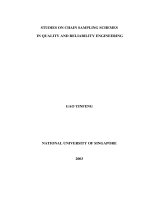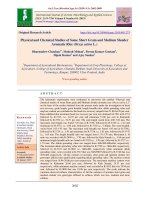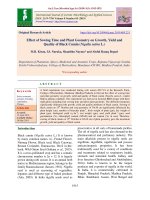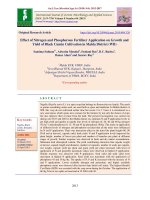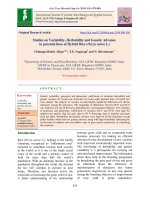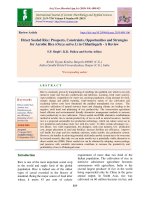Studies on sources and levels of organic manures on yield, yield attributes and quality of black cumin (Nigella sativa L.)
Bạn đang xem bản rút gọn của tài liệu. Xem và tải ngay bản đầy đủ của tài liệu tại đây (234.28 KB, 7 trang )
Int.J.Curr.Microbiol.App.Sci (2019) 8(8): 2687-2693
International Journal of Current Microbiology and Applied Sciences
ISSN: 2319-7706 Volume 8 Number 08 (2019)
Journal homepage:
Original Research Article
/>
Studies on Sources and Levels of Organic Manures on Yield, Yield
Attributes and Quality of Black Cumin (Nigella sativa L.)
M. B. Sanjeeva1, G. Gangadhar Eswar Rao2* and V. Venkatachalapathi3
Research Institute on Organic Farming, University of Agricultural Sciences, GKVK,
Bengaluru-560065, India
*Corresponding author
ABSTRACT
Keywords
Black cumin, Organic
Manures, Bio-digester
liquid organic manure,
black cumin fixed oil,
volatile oil (%)
Article Info
Accepted:
22 July 2019
Available Online:
10 August 2019
A field experiment entitled “studies on sources and levels of organic
manures on yield, yield attributes and quality of black cumin” was
conducted at RIOF, UAS, GKVK, Bengaluru during rabi 2017. The
experiment was laid out in RCBD with 12 treatments replicated thrice and
the cultivar used was Ajmer Kalonji-1. Results revealed that application of
125 per cent N equivalent through vermicompost recorded significantly
higher seed yield and fixed oil yield (723 and 261 kg ha-1, respectively).
This was attributed mainly by enhanced yield attributes like days to 50 per
cent flowering (52.34), number of pods per plant (28.67), size of pods (3.00
cm2) and seeds per pod (87.33), 1000 seed weight (2.39 g) and quality
parameters like fixed oil (36.20 %) and volatile oil (0.70 %). Significantly
lower yield and yield attributes, quality of black cumin was recorded in
application of 75 per cent N equivalent through compost.
Introduction
A strong and prosperous agriculture is
necessary for the economic growth and
development of the country. Agriculture is one
of the oldest and most prospective professions
of human civilization whose success depends
on soil organic matter status.
Organic farming gives major emphasis on
recovery and maintenance of soil fertility and
sustainable yield. Organic farming helps to
improve the physical, chemical and biological
properties of soil and maintains the ecological
balance as well as productivity of life
supporting system for the future generations.
Organic farming is gaining momentum all
over the world as it addresses self-reliance in
food, rural development and conservation of
natural ecosystem and sustained biodiversity
(Pathak and Ram, 2006). Due to increasing
health consciousness in recent years, organic
products have gained niche position in global
food market ($ 100 billion) particularly in
developed countries.
2687
Int.J.Curr.Microbiol.App.Sci (2019) 8(8): 2687-2693
Organic manures constitute a dependable
source of essential nutrients besides improving
the soil physical, chemical and biological
conditions. The management of nutrients in
organic farming systems presents a formidable
challenge, as the use of inorganic fertilizers is
not permitted. Therefore, organic must
optimize a range of soil, crop rotation and
manure managements to ensure a nutrient
supply which will guarantee optimum crop
yields and minimize losses to the
environment. To achieve this objective, an
appreciation of the nutrient cycles in farming
systems is essential which is possible through
various agronomic practices i.e., crop rotation,
cover cropping, application of compost, FYM,
green leaf manure, crop residues, animal
manure liquid organic manure and biofertilizers.
Black cumin (Nigella sativa L.) belonging to
the family Ranunculaceae, is an annual
herbaceous spice crop. The seeds are
economically important and they contain 36 to
38 per cent fixed oil and 0.5-1.0 per cent
volatile oil. The most important active
compounds are thymoquinone (30–48 %),
thymohydroquinone, dithymoquinone, pcymene (7–15 %), carvacrol (6-12%), 4terpineol (2-7 %), t-anethol (1-4 %),
sesquiterpene longifolene (1-8 %) α-pinene
and thymol etc. Black cumin seeds also
contain some other compounds in trace
amounts. Seeds contain two different types of
alkaloids; i.e. isoquinoline alkaloids and
pyrazol alkaloids or indazole ring bearing
alkaloids. Moreover, N. sativa seeds also
contain alpha-hederin, a water soluble
pentacyclic triterpene and saponin, a potential
anticancer agent (Al-jassir, 1992).
Black cumin seed is an expensive spice, the
seeds are used both as a seed spice and also
for medicinal purposes. Essential oil of this
spice is extensively used in pharmaceutical
industries.
Materials and Methods
A field experiment was carried out during
rabi2017 at RIOF experiment block, Gandhi
Krishi
Vignana
Kendra,
Bengaluru.
Bengaluru. Soil of the experimental site was
red sandy loam classified as Alfisols. Organic
carbon, available nitrogen, phosphorus and
potassium content of the soil were medium.
The experiment was laid out in randomized
complete block design (RCBD). The
experiment was laid out with 12 treatments
consisting of different levels and combination
of organic manures.
Application of manures
Well decomposed farm yard manure @ 7.5 t
ha-1 was applied to all the treatments
considering 0.4 per cent of N in FYM. The
farm yard manure was incorporated into the
soil by using hand fork. Compost,
vermicompost and biodigester manures were
analyzed for their nutritive value. Compost
and vermicompost was applied as a basal dose
and the biodigester liquid organic manure
applied in split dose according to treatments
details.
The seeds of black cumin cultivar Ajmer
kalonji -1 were sown at spacing of 30 cm wide
rows at 1 cm depth with a seed rate of 5 kg ha1
. The furrows were covered properly and the
plots were irrigated lightly after sowing.
Excess seedlings were thinned out manually
21 days after sowing and two healthy
seedlings were retained per hill. The plots
were irrigated lightly after sowing and
thereafter at an interval of 5-6 days during the
entire cropping period depending on the soil
moisture conditions. Good drainage was
provided to prevent water logging.
Observations on days to 50 % flowering yield,
yield attributes & quality were recorded at
harvest.
2688
Int.J.Curr.Microbiol.App.Sci (2019) 8(8): 2687-2693
cent N equivalent through vermicompost has
recorded higher days for 50 % flowering
(52.34). (Table 2)
Quality analysis
Fixed oil content
Fixed oil content of the black cumin was
determined by extracting the oil by using the
method of oil extraction by soxtherm
apparatus.
Fixed oil yield per hectare
The fixed oil yield per hectare was calculated
on the basis of seed oil content and seed yield
obtained per hectare and expressed in
kilograms per hectare.
Oil yield (kg ha-1) = Oil content (%) x Seed
yield
Volatile oil content
Volatile oil is extracted using Clevenger
apparatus, its works based on the principle of
hydro distillation.
Weight of extracted oil
Oil content (%) = -------------------------- × 100
Weight of sample
Experimental data collected was subjected to
statistical analysis by adopting Fisher‟s
method of Analysis of Variance (ANOVA) as
outlined by Gomez and Gomez (1984).
Critical Difference (CD) values were
calculated whenever the „F‟ test was found
significant at 5 per cent level.
Whereas, different organic manures at
different levels and their combination resulted
in significant difference among the treatments,
in which application of 125 per cent N
equivalent through
vermicompost has
recorded significantly higher seed yield (723
kg ha-1) & stalk yield (1467 kg ha-1) Table 1.
This is due to increased yield attributes viz.,
pods per plant (28.67), seeds per plant (87.33),
pod size (3.00 cm2), 1000 seed weight (2.39 g)
& shelling percent (57.67 %) recorded in T6
i.e, application of 125 per cent N equivalent
through vermicompost. However, it was on
par with application of 50 per cent N
equivalent through vermicompsot + 25 per
cent N equivalent through compost + 25 per
cent N equivalent through biodigester liquid
organic manure i.e., T11 (656 kg ha-1 seed
yield; 1331 kg ha-1 stalk yield) 25.00, 85.00,
2.86 cm2, 2.24 g & 55.17 % yield attributes
respectively) followed by application of 100
per cent N equivalent through vermicompost
i.e., T5. Significantly lower yield and yield
attributes were recorded at T1 (application of
75 per cent N equivalent through compost).
Table 1 & 2
The important reason responsible for better
production of yield attributes and yield could
be due to the supply of nutrients in balanced
amount and available form.
The increased growth in terms of plant height,
branches per plant and expansion of leaf
lamina
provided
greater
sites
for
photosynthesis
and
diversion
of
photosynthates towards sink (pods and seed).
Results and Discussion
Yield & Yield attributes
Application of different organic manures at
different levels and their combination on days
to 50 % flowering was found to be nonsignificant; however application of 125 per
These results are in conformity with the
findings of Darzi et al., (2012) in Pimpinella
anisum and Nuthana (2017) in black cumin.
2689
Int.J.Curr.Microbiol.App.Sci (2019) 8(8): 2687-2693
Table.1 Influence of sources and levels of organic manures on seed yield, stalk yield, fixed oil, volatile oil and
Fixed oil yield of black cumin
Treatments
Seed Yield (kg ha-1)
Stalk yield (kg ha-1)
Fixed oil (%)
Volatile oil (%)
Fixed oil yield (kg ha-1)
335
861
19.50
0.41
65
T1
403
940
25.20
0.47
102
T2
457
971
29.40
0.52
135
T3
452
1162
27.27
0.54
124
T4
635
1349
35.27
0.67
224
T5
723
1467
36.20
0.70
261
T6
413
1011
20.00
0.45
83
T7
490
1090
26.37
0.52
128
T8
515
1094
31.40
0.56
162
T9
498
1280
26.37
0.54
130
T10
656
1331
34.00
0.66
223
T11
540
1096
28.97
0.56
156
T12
S.Em±
32
47
1.52
0.017
13
CD (P=0.05)
92
140
4.8
0.051
37
T1: 75 % N equivalent through compost
T10: 50 % N equivalent through compost + 25
% N equivalent through vermicompost + 25 % N
T2: 100 % N equivalent through compost
equivalent through bio digester liquid organic manure (30
T3: 125 % N equivalent through compost
DAS)
T4: 75 % N equivalent through vermicompost
T11: 50 % N equivalent through vermicompost
T5: 100 % N equivalent through vermicompost
+ 25 % N equivalent through compost + 25 % N equivalent
T6: 125 % N equivalent through vermicompost
T7: 75 % N equivalent through bio digester liquid organic manure (50 % as a through bio digester liquid organic manure (30 DAS)
T12: 50 % N equivalent through bio digester liquid organic
basal and 50 % at 30 DAS)
T8: 100 % N equivalent through bio digester liquid organic manure (50 % as a manure (30 DAS) + 25 % N equivalent through compost +
25 % N equivalent through vermicompost
basal and 50 % at 30 DAS)
T9: 100 % N equivalent through bio digester liquid organic manure (50 % as a
basal and 50 % at 30 DAS)
2690
Int.J.Curr.Microbiol.App.Sci (2019) 8(8): 2687-2693
Table.2 Influence of sources and levels of organic manures on days taken for 50 per cent flowering, pods per plant, seeds per pod, pod
size, 1000 seed weight and shelling % of black cumin
Treatments
T1
T2
T3
T4
T5
T6
T7
T8
T9
T10
T11
T12
S.Em±
CD (P=0.05)
Days to 50 per
cent flowering
49.67
50.00
51.00
49.00
52.00
52.34
49.67
49.34
50.34
50.00
51.67
49.00
0.94
NS
Pods
plant-1
17.00
20.57
24.00
22.00
25.00
28.67
18.67
23.50
24.67
21.67
25.00
23.33
1.333
3.336
Seeds
pod-1
72.9.
78.33
80.00
78.33
83.33
87.33
74.93
77.67
80.33
76.33
85.00
80.33
2.107
6.317
Pod size
(cm-2)
2.06
2.34
2.42
2.32
2.81
3.00
2.25
2.48
2.67
2.35
2.86
2.69
0.063
0.184
T1: 75 % N equivalent through compost
T2: 100 % N equivalent through compost
T3: 125 % N equivalent through compost
T4: 75 % N equivalent through vermicompost
T5: 100 % N equivalent through vermicompost
T6: 125 % N equivalent through vermicompost
T7: 75 % N equivalent through bio digester liquid organic manure (50 % as a
basal and 50 % at 30 DAS)
T8: 100 % N equivalent through bio digester liquid organic manure (50 % as a
basal and 50 % at 30 DAS)
T9: 100 % N equivalent through bio digester liquid organic manure (50 % as a
basal and 50 % at 30 DAS)
2691
1000 seed
weight (g)
Shelling
per cent
1.79
1.85
2.02
1.98
2.19
2.39
1.87
2.01
2.11
2.14
2.24
2.15
0.076
0.193
48.00
51.67
52.97
49.77
53.97
57.67
48.37
52.67
52.77
49.87
55.17
51.97
0.92
2.70
T10: 50 % N equivalent through compost + 25
% N equivalent through vermicompost + 25 % N equivalent
through bio digester liquid organic manure (30 DAS)
T11: 50 % N equivalent through vermicompost
+ 25 % N equivalent through compost + 25 % N equivalent
through bio digester liquid organic manure (30 DAS)
T12: 50 % N equivalent through bio digester liquid organic
manure (30 DAS) + 25 % N equivalent through compost + 25
% N equivalent through vermicompost
Int.J.Curr.Microbiol.App.Sci (2019) 8(8): 2687-2693
The increased photosynthesis might be due to
increased biological activities of soil and
mineral element absorption such as; nitrogen
and phosphorus (Jat and Ahlawat, 2006).
Quality parameters
Significantly higher fixed oil content (36.20
%), volatile oil (0.70 %) fixed oil yield (261
kg ha-1) was recorded in application of 125
per cent N equivalent through vermicompost.
(Table 1). It was found to be on par with T11.
Significantly higher fixed oil, volatile oil and
fixed oil yield obtained in application of
125% N equivalent through vermicompost,
because of better growth of plant and
favorable nutritional environment for the
supply of nutrients in balanced form and in
adequate amount and also more availability of
phosphorous (Zaller, 2007), this might be
attributed to the fact that phosphorus is
required for production of high quality seed,
since it operates in coenzymes involved in
energy transfer reactions. Energy is tapped in
photosynthesis in the form of adenosine
triphosphate (ATP) and nicotinamide adenine
dinucleotide phosphate (NADP). This energy
is then used in photosynthetic fixation of CO2
and in synthesis of lipids and other essential
organic compounds.
These results are in conformity with the
findings of El deen and Ahmed (1997) in
black cumin and Nuthana (2017) in black
cumin
Application of 125 per cent N equivalent
through vermicompost resulted in better yield,
yield attributes and quality parameters.
It was found on par with application of 50 per
cent N equivalent through vermicompsot + 25
per cent N equivalent through compost + 25
per cent N equivalent through biodigester
liquid organic manure and also with
application of 100 per cent N equivalent
through vermicompost. Hence, these organic
manures, liquid formulations and there
combination are efficient organic substitutes
for obtaining higher crop yield besides
improving the nutrient status of the soil.
References
Al-Jassir MS. Chemical composition and
microflora of black cumin (Nigella
sativa L.) seeds growing in Saudi
Arabia. 1992, Food Chem., 45: 239–
242.
Darzi MT, Haj Seyed Hadi MR and Rejali
F. Effects of the application of
vermicompost
and
phosphate
solubilizing
bacterium
on
the
morphological traits and seed yield of
anise (Pimpinella anisum L.). 2012, J.
Medicinal Plants Res., 6(2): 215-219.
El Deen E and Ahmed T. Influence of plant
distance
and
some
phosphorus
fertigation sources of black cumin
(Nigella sativa Linn.) plants. 1997,
Assiut. J. Sci., 28(2): 39-56.
Gomez KA and Gomez AA. Statistical
procedures agricultural research, (2/e)
an international rice research institute
book. 1984, A Willey Inter Science
Publication, John Willey and Sons, New
York.
Nuthana G. Integrated nutrient management
in black cumin (Nigella sativa L.).
2017, M. Sc. (Agri.) Thesis, Univ.
Agric. Sci., Bengaluru (India).
Zaller JG. Vermicompost as a substitute for
peat in potting media: Effects on
germination, biomass allocation, yields
and fruit quality of three tomato
varieties. 2007, Sci. Hortic., 112: 191199.
2692
Int.J.Curr.Microbiol.App.Sci (2019) 8(8): 2687-2693
How to cite this article:
Sanjeeva M. B., G. Gangadhar Eswar Rao and Venkatachalapathi V. 2019. Studies on Sources
and Levels of Organic Manures on Yield, Yield Attributes and Quality of Black Cumin
(Nigella sativa L.). Int.J.Curr.Microbiol.App.Sci. 8(08): 2687-2693.
doi: />
2693
